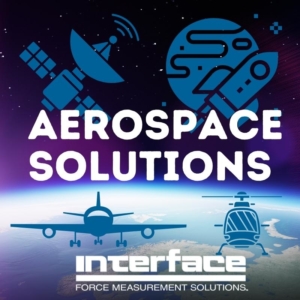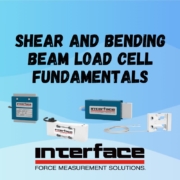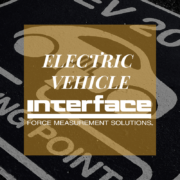Examining Interface Aerospace Industry Solutions
 Among the many industries Interface serves, the aerospace industry is one of the fastest growing users of our precision force measurement solutions. This is because ultra-accurate force, weight and torque measurements and data are critical to testing, performance and safety for airplanes, helicopters, and rockets.
Among the many industries Interface serves, the aerospace industry is one of the fastest growing users of our precision force measurement solutions. This is because ultra-accurate force, weight and torque measurements and data are critical to testing, performance and safety for airplanes, helicopters, and rockets.
Aerospace engineers and manufacturers of commercial, industrial, and military aerospace vehicles and associated components must measure multitudes of factors such as fatigue, structure durability, materials, weight distribution, drag, effects of inclement weather, velocity changes, thrust, and center of gravity to name a few.
Interface is synonymous with high performance sensors used for all types of test and measurement applications. For more than five decades, aerospace innovators and industrial giants have relied upon Interface to provide precision products and services they can trust. Our test and measurement solutions are designed for use in the aerospace industry to withstand extreme conditions, whether they are for testing wings on commercial airplanes or used to measure the force of an intergalactic vessel launch.
Interface showcases products and use cases in our new aerospace solutions brochure detailing many the products and custom solutions we provide to the industry. We provide an overview of our accurate and reliable lineup of force measurement products, as well as highlighting various application examples to outline different ways we have long served the makers, builders, testers and engineers across the diverse aerospace industry.
To work in the aerospace industry, you have to meet the highest quality industry requirements in manufacturing and calibration. We take our commitment towards quality assurance very seriously and guarantee our products meet or exceed the quality clauses outlined by the International Organization of Standardization (ISO). We test and calibrate all products we build in a certificated lab based in Arizona that holds A2LA, International Standard ISO/IEC 17025:2017 and ANSI/NCSL Z540-1- 1994 accreditations. The strict adherence to these standards demonstrates our technical competence for a defined scope and the operation of a laboratory quality management system. Every Interface manufactured sensor goes through rigorous testing and calibration before it’s released to our customers.
The sensors, instrumentation, and accessories we supply to aerospace equipment manufacturers and testing labs range from mini to jumbo load cells, torque transducers, multi-axis sensors, and various wireless, digital and analog instrumentation devices. Interface sensors have been used regularly in the engineering and testing of military aircraft, missiles, space, commercial airliners, and for general aviation components as demonstrated in this aerospace and defense industry case study.
One aerospace use case of our force sensors is for structural testing. Interface LowProfile™ Load Cells are utilized for structural static and fatigue testing. Our moment and temperature compensated load cells use proprietary alloy strain gages for extreme accuracy and reliability. Using eight proprietary strain gages per sensor, our 4mV/V output well exceeds the performance. These load cells are offered in single, dual, and triple bridge configurations for different data acquisition and control requirements in aerospace vehicle production.
The range of aircraft and space vehicles that use Interface solutions include all types from unpowered gliders to commercial and military aircraft, as well as rockets, missiles, drones, launch vehicles, and spacecraft. These vehicles go through extensive and rigorous test and measurement programs and processes requiring the reliability and accuracy of Interface made products. Here are a few types of aerospace applications using Interface measurement solution:
- Aircraft Wing Fatigue Testing
- Rocket Structural Testing
- Landing Gear Joint Testing
- Hoist Tests for Aircraft Engines
- Helicopter and Parachute Tests
- Vessel Launch Tests
- Wind Tunnel and Environmental Condition Testing
- Reduce Gravity Simulations
Aircraft Wing Fatigue
Before any of the U.S. Navy’s F/A-18 twin-engine supersonic fighter jets can be put into operation, the wings of the aircraft must undergo fatigue testing in a controlled environment to ensure that they are capable of withstanding the forces that will be encountered during real-world flight throughout the lifetime of the aircraft. Highly accurate measurements must be recorded in order to make sure that a near-exact replication of in-flight conditions are being achieved. During fatigue tests, Interface’s 1248 Standard Precision Flange LowProfile Load Cells are installed in line with the hydraulic cylinders, which apply back-and-forth loading forces to the aircraft. This is carried out over the course of 18 months to simulate in-flight stresses and strains on the wings. Load cells are connected to indicators, which record output. Capable of withstanding more than 100 million (1×108) fully reversible load cycles, Interface’s LowProfile Fatigue-Rated Load Cells have performed flawlessly in F/A-18 wing testing with zero recorded failures in the many years that testing facilities around the world have been using them.
Rescue Helicopter Hoist Test
When a customer wanted to test the strength of the cable line used in the hoist of their helicopter during rescue missions and situations, see if both the cable and the hoist can withstand a heavy load safely, and for long periods of time while the helicopter is in flight, they turned to Interface. We supplied a WTSSHK-D Wireless Crosby™ Load Shackle, which is attached to each mooring cable in use. Results are sent to the customers through the WTS-BS-4 USB Industrial Base Station when connected to the customer’s supplied computer. Data can also be transmitted to the WTS-BS-1-HS Handheld Display for Single Transmitters, giving the customer the option to view mooring cable line tension. Using this solution, the customer was able to add a heavy load to the end of the helicopter hoist, to ensure it is strong and safe enough to carry both rescue personnel and objects while being in midair.
The aerospace industry is responsible for some of the greatest inventions and innovation in our global history. The engineering and manufacturing of a single rocket engine design, using handwritten calculations and with less computing power than a modern smartphone, took us to the moon. The aerospace industry is an assembly of researchers, design houses, test labs and manufacturing companies that engineer and build vehicles to travel within and beyond Earth’s atmosphere using Interface products. Whether you need a million-pound jumbo load cell, custom load pin, or wireless instrumentation, we understand aerospace requirements and our engineers are on stand-by to assist. Get your copy of our new Aerospace Solutions Brochure here.
Additional Resources
Solutions Provider for Aerospace & Defense
Exploring Aerospace Force Measurement Solutions
Interface Displays Force Measurement Aerospace Applications at Space Tech Expo








